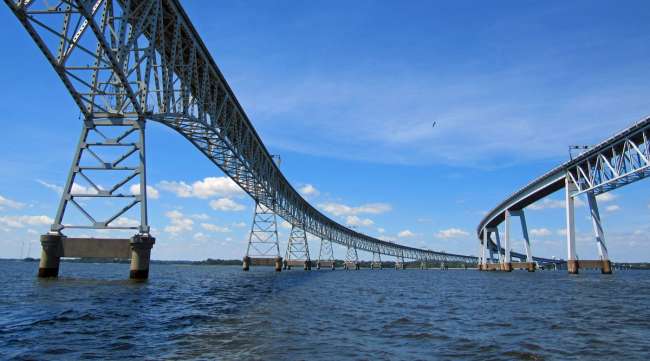The Virginian-Pilot
Lawsuit Blames Bridge Owners in Trucker's High-Wind Fatal Accident

[Stay on top of transportation news: Get TTNews in your inbox.]
Billie Joe Chen, the widow of a trucker who died after his rig plunged off the Chesapeake Bay Bridge-Tunnel in 2017, is suing the CBBT for $6 million.
The lawsuit says that, according to the bridge-tunnel’s own wind gauge and policy, Joseph Chen should not have been allowed to cross the span when he was given a green light that blustery day.
CBBT policy says empty trailers like Chen was hauling are not allowed to cross if gusts higher than 46 mph are being detected by gauges stationed along the 17.6-mile span.
In part one of a two-part exploration of autonomous technology today, our latest RoadSigns podcast revisits conversations with CEOs Alex Rodrigues of Embark and Cetin Mericli of Locomation. Hear them explain what testing automated trucks and developing platooning technology has taught them about the road ahead — and get new perspective with host commentary. Listen to a snippet from Rodrigues above, and to hear the full episode, go to RoadSigns.TTNews.com.
But according to readouts of a WeatherHawk gauge at the CBBT’s Island 4 — the nearest one to where Chen went over the side — gusts up to 50 mph were clocked while he attempted his crossing.
The readouts, collected minute-by-minute, are included in the lawsuit.
Attorneys with Pender & Coward, the Virginia Beach firm representing the CBBT, did not respond to interview requests last week from The Virginian-Pilot. But according to court filings, the CBBT is claiming sovereign immunity, a shield that typically blankets governmental entities, protecting them from negligence lawsuits.
Douglas Desjardins, the Washington-based attorney representing Chen’s widow, said his firm searched for comparable cases against the CBBT and found none, despite the fact that 16 vehicles have gone into the water since the span opened in 1964, most of them tractor-trailers.
Desjardins’ firm, the Pangia Law Group, specializes in transportation-related cases. He says sovereign immunity challenges have hope “if an entity has established policies and you can prove that it fell short of its own standards.”
In Chen’s case, Desjardins believes, the wind gauge tells the story.
Fateful day
CBBT officials “aren’t allowed to discuss legal matters,” said Tom Anderson, the facility’s assistant director.
In the past, though, they’ve cited the bridge-tunnel’s safety record: more than 100 million problem-free crossings.
In a story published shortly after Chen’s accident, CBBT Police Chief Edward Spencer said, “Any time there’s a loss of life, it’s a terrible tragedy. But there were 80 to 86 trucks out there on the facility at the time of the incident, and they all made it across except him.”
A CBBT police investigation concluded that Chen caused his own accident. Several witnesses said he was going too fast for conditions and lost control when he tried to pass another semi.
But Desjardins spoke to another witness who said Chen’s trailer was picked up by the wind “like a sail” right before his rig hurtled through the guardrail. Divers recovered the “black box” from his sunken cab, but it was too damaged to yield any information about speed or braking.
What’s not in dispute: Tractor-trailers are susceptible to blowovers in strong winds — and the lighter their loads the greater the danger. To address that, the CBBT uses a six-level system of traffic restrictions that clamps down on certain types of vehicles as wind escalates.
Level 1 — instituted when gusts reach 40-46 mph — is the highest level under which empty tractor-trailers are allowed to cross.
Chen was 47 when he died, an experienced driver delivering seafood for Evans Transport, a company based near Chen’s home in Greenville, N.C.
On Feb. 9, 2017, he was on the homebound leg of a route that had carried him up I-95, across into Maryland and down the Eastern Shore. By the time he neared the CBBT that Thursday morning, his trailer held little more than pallets. A powerful storm had moved into the area and the bridge-tunnel was operating with Level 4 restrictions: 60-64 mph gusts that kept all tractor-trailers off the span no matter how much weight they were carrying.
Scores of truckers were waiting it out, bottled up at both ends of the bridge-tunnel.
At 12:01 p.m., restrictions were lowered straight to a Level 1. That’s where Desjardins says CBBT personnel made a mistake.
At that time, the gauge at Island 4 was registering 47 mph. That’s Level 2 strength — which would have triggered toll takers to check manifestos for weight and kept Chen off the span.
Instead, Chen jockeyed for a place in the unleashed stream of semis, heading for the mouth of the bay even as the wind gauge bounced higher.
At 12:15 p.m., when the suit says Chen entered the north end of the span, the Island 4 gauge detected a 49-mph gust. His Kenmore climbed the high-rise section of the bridge and down the other side, reaching a stretch near mile marker 15 where the span shifts more southwest, an angle that put traffic broadside to the northwest wind.
At 12: 21 p.m., when Chen’s front tires hit the curb and his rig catapulted through the guardrail, the Island 4 gauge clocked a 50-mph gust.
Since the accident, the CBBT has tweaked its wind restrictions: They made them looser.
Level 2 used to require a minimum payload of 30,000 pounds for tractor-trailers. Now, it’s 15,000.
Level 3’s minimum was 40,000 pounds. Now, 30,000.
Questions posed to CBBT officials about when and why those changes were made have not been answered.
The lawsuit is expected to go to trial in July.
Want more news? Listen to today's daily briefing:
Distributed by Tribune Content Agency, LLC


